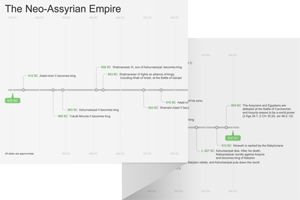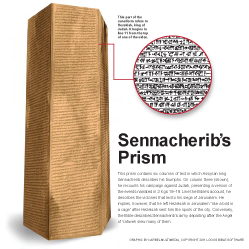10:2 to guide the needy away from legal claims See Isa 5:23. Refers to the injustice of the rich and powerful exploiting the poor and weak. Isa 10:1–4 connects to the similar “Woe” sayings in 5:8–30; those sayings also condemned the leaders of Judah for disregarding their responsibility to deal fairly with the poor and weak.
10:4 his anger has not turned away The same phrase occurs in 5:25. See note on v. 2.
10:5 Assyria, the rod of my anger Yahweh used Assyria to punish Israel. Victory in the ancient world was often attributed to the superiority of one’s god. Yahweh is thus presented as truly superior—He, not Assyria’s god, is behind their success. The foreign nations are simply tools in the hands of Yahweh.
10:6 a godless nation Israel is considered godless since it had turned away from Yahweh. See 9:17.
the clay of the streets Assyria will trample everything in its path like dirt on the roads, leaving behind a muddy mess.
10:8–14 Assyria’s arrogance is revealed in this self-confident speech. The king of Assyria believes his military victories represent spiritual victories over the idols of the cities he has conquered. He also elevates himself to demigod status, boasting in his own strength, wisdom, and understanding. |
10:8 not my commanders altogether kings The Assyrian Empire turned conquered kings into subject vassals, so the king of Assyria could rightly boast that his subject commanders were kings in their own right. Many ancient inscriptions from this period attest to this practice, including the Bar-Rakib stele, where the king of Sam’al declares his loyalty to Tiglath-Pileser, king of Assyria.
10:9 not Samaria like Damascus The king boasts over the cities he has conquered. Each pair moves geographically closer to Israel.
10:10 images Assyria has already conquered stronger city-states than Israel and Judah. The boast is asserted in a religious sense—the cities with the most powerful gods already fell. See 37:12–13.
10:12 all his work Refers to the predicted judgment.
Mount Zion Yahweh’s holy mountain, the location of the temple. Symbolically, Zion often refers to the city of Jerusalem. Here they are mentioned separately. See note on 1:8; note on 2:2.
I will punish Assyria will also be judged for pride and arrogance once Israel’s punishment is complete. See note on v. 5.
10:13 by the strength of my hand The king of Assyria believes his victory is the result of his own strength and cunning.
10:15 the ax boast against the one who cuts God used Assyria to bring judgment on rebellious Israel and Judah, but the Assyrians are still accountable for their actions and their arrogance. A tool is useless on its own. Assyria is judged for not recognizing that it is only a tool in the hand of God.
10:16 will send leanness See 37:36.
10:17 in one day See 9:14 and note. The Assyrian king Sennacherib abruptly leaves his siege of Jerusalem. See 37:37.
10:20 the remnant of Israel Contrasts with the imagery in v. 19, which depicts the destruction of Assyria until only a remnant of forest remains. See note on 1:9.
the survivors of the house of Jacob See 1:9 and 4:2.
10:21 A remnant will return Refers to a spiritual, not necessarily physical, return. The phrase “a remnant will return” is also the name of Isaiah’s first son, Shear-Jashub. See 7:3 and 8:18.
10:22 like the sand of the sea The Apostle Paul quotes this verse in Rom 9:27–28.
overflowing with righteousness See Isa 28:22. God’s judgment is righteous and necessary.
10:24 Assyria This people group came from central Mesopotamia on the Tigris River. They were the dominant power in the ancient Near East during the eighth and seventh centuries BC.
The land of Assyria |
10:26 as when Midian was defeated The coming deliverance is compared to God’s victory over Midian in Judg 7:19–25.
as he did in Egypt Refers to the parting of the Red Sea in Exod 14:15–31.
10:28–32 The path of the Assyrian invaders is laid out from the northeast part of Judah to the vicinity of Jerusalem. The place names are mentioned in order, drawing geographically closer and closer to the immediate vicinity of Jerusalem. |
10:32 he will shake his fist at the mountain of Assyria gets close enough to threaten Jerusalem, but does not conquer her.
Zion Refers to Jerusalem. See note on Isa 1:8.
10:33 is about to lop off the branches with great power Assyria was metaphorically depicted as a tool in the hand of God in vv. 14–15. In vv. 33–34 that metaphor is turned about as the is cut down to size.

|
About Faithlife Study BibleFaithlife Study Bible (FSB) is your guide to the ancient world of the Old and New Testaments, with study notes and articles that draw from a wide range of academic research. FSB helps you learn how to think about interpretation methods and issues so that you can gain a deeper understanding of the text. |
| Copyright |
Copyright 2012 Logos Bible Software. |
| Support Info | fsb |
 Loading…
Loading…




 Assyrians
Assyrians  straddled the upper Tigris River. It was almost completely surrounded by mountains: the Zagros in the east, the Armenian in the north, the Hamrin Hills in the south, and a low-lying ridge in the west that separated the Assyrian heartland from the Jazira steppe. Assyria was governed by a collection of powerful city-states, including Ashur (sometimes spelled “Asshur”), Calah, and Nineveh. The Assyrian religion was
straddled the upper Tigris River. It was almost completely surrounded by mountains: the Zagros in the east, the Armenian in the north, the Hamrin Hills in the south, and a low-lying ridge in the west that separated the Assyrian heartland from the Jazira steppe. Assyria was governed by a collection of powerful city-states, including Ashur (sometimes spelled “Asshur”), Calah, and Nineveh. The Assyrian religion was 